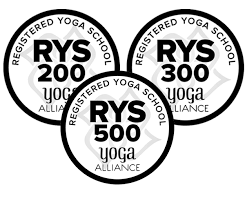Yoga Alliance USA
Yoga Teacher Training Syllabus
The best International Yoga Teacher Training Course 200 hours
At Samarpan School of Yoga ), Swami Samarpan Ashram, Ghughtani Malli ,Tapovan, Uttarakhand,Rishikesh, Himalayas
Daily Schedule of TTC except Sundays Holiday:
- 07:00 am: Wake up
- 08.00 am to 10.00 am: Practice of TTC
- 10.00am to 10.30am : Breakfast
- 10:30 am to 12.00 am: Practice of TTC , which is Karma Yoga /Seva/ Service without expectations
- 12:00am to 01.00 pm.... Self Study Part of TTC
- 01.00pm to 01.30 pm... Lunch
- 03.00 pm to 03.15pm.... Tea Break
- 04:00pm to 7.00 pm.... Theory and Practice of TTC
- 07:30 pm..,..Dinner
- 09.00 Rest
Living Gurukul Study
1. ASANAS 2.PRANAYAMA 3.KRIYAS 4.YOGA ANATOMY 5.PHYSIOLOGY 6.KARMA YOGA 7.REINCARNATION 8.TEACHING PRACTICE 9.YOGA NUTRITION 10. HATHA YOGA 11. RAJA YOGA 12. KUNDALINI TANTRA 13.BHAKTI YOGA 14. PSYCHOLOGY OF YOGA 15.JNANA YOGA
CURRICULUM
The goal of this training program is to produce qualified and inspiring yoga teachers who are able to draw on their own practice and personal discipline in imparting the yoga experience to others. The curriculum is based on the five points of yoga which can be understood as the practical application of the traditional four paths of yoga. The intensive daily schedule includes two meditation sessions, two yoga classes, two lectures, one hour of service to the ashram community. One day a week is lecture-free.
- ASANAS (YOGA POSTURES)A daily teaching practice class is devoted to teaching you how to teach asanas and pranayama. A daily asana practice class gives you the opportunity to practice your own asanas and will help to build the good habit of practice. The daily in-depth practice with individual corrections comprises:
- Sun salutation
- 12 basic yoga postures
- 100 asana variations, from intermediate level to advanced
- Postural alignment
- Deep relaxation with autosuggestion
- Release of blocked energy
- Training sessions for all age groups
BENEFITS OF ASANAS:
- Control emotions
- Improve power of concentration
- Rid the body of excess fat
- Enhance physical fitness
- Relieve chronic ailments such as constipation, rheumatism, stomach complaints
- Stimulate circulation
- Stabilise thyroid functions
- Keep muscles youthful and supple into old age
PRANAYAMA
- Expands capacity of the lungs
- Relaxes the nervous system
- Balances the two hemispheres of the brain
- Purifies the nadis (subtle energy channels)
- Awakens the inner spiritual energy
- Kapalabhati (lung cleansing exercise)
- Anuloma Viloma (alternate nostril breathing)
- Ujjayi, Surya Bheda, Bhastrika, Sitali, Sitkari, Bhramari
- Samanu (mental cleansing of the nadis)
- The three bandhas: Jalandhara, Moola, Uddiyana
KRIYAS
Tratak, Neti, Kapalabhati, Dhauti, Nauli and Basti: six classical purification exercises for the eyes, nose, air passages, oesophagus and stomach, abdominal organs and large intestine. Explanation and demonstration of the exercises and their effects. Individual instruction
YOGA ANATOMY AND PHYSIOLOGY
- Introduction to the major body systems
- The effects of asanas and pranayama on: the cardiovascular system, respiration, digestion, skeletal and muscular systems, endocrine system
- The eight systems of the body
- Yoga and physical culture
- Diet and nutrition
KARMA AND REINCARNATION
- The law of action and reaction
- The law of compensation
- The law of retribution
- Destiny and self-effort
TEACHING PRACTICE
- How to teach the 12 basic postures and breathing exercises to beginners and intermediate students
- Setting up of a proper environment for class
- General pointers on teaching a class
- Beginners' Course
- Advanced Postures
- Relaxation
- Detailed correction workshops
- In the second half of the training course, participants will teach each other under the guidance of an experienced instructor
YOGA NUTRITION
- Vegetarianism – for ethical, spiritual and health reasons
- How diet affects the mind
- Proper balance of the main nutrients
- Ayurvedic principles of nutrition
- Healing effects of fasting
- MEDITATION
- Guide to meditation
- What is meditation
- Why meditate
- Physical and mental meditation
- 12-step daily practice
- Effects of and experiences in meditation
- Mantras – spiritual energy in sound
- Mantra initiation (if desired)
HATHA YOGA
- Ethical and moral principles
- Body – prana (life energy) – mind
- From control over the body to control over the mind and meditation
RAJA YOGA
- Ashtanga - the 8 steps of yoga
- Antahkarana - functions of the mind
- Concentration and meditation
KUNDALINI YOGA
- The Absolute and how it manifests itself in nature
- Macrocosmos & microcosmos
- The 7 Chakras
- The awakening of cosmic energy
BHAKTI YOGA
- Kirtan: chanting of classical Sanskrit mantras
- Indian gods and their cosmic meaning
- Arati and Pujas (traditional Indian rituals)
- Chanting opens the heart and purifies the mind. With daily chanting, you develop a strong feeling of devotion and a very pure vibration. In devotional chanting correct pronunciation, devotional attitude and awareness of meaning are all-important.
KARMA YOGA
- Karma yoga is the practice of selfless service and helps to reduce selfishness and egoism and keeps you fit and healthy and gives immeasurable joy
- ou will be asked to do various tasks within the Ashram setting including gardening, cooking, cleaning, office work and any other work necessary for the smooth running of the community
- The law of cause and effect
- Samsara – the wheel of birth and death
- Karma Yoga - selfless service: one hour daily in the ashram community
JNANA YOGA
- Basic concepts of Vedanta philosophy
- The 7 Bhoomikas or planes of consciousness
- Space, time, causation
- The 3 bodies
- The 3 levels of the mind
- Conquest of death
Satsang means being in companionship with the truth and with the wise. The course satsang consists of half an hour silent meditation, half an hour chanting and a talk or reading on aspects of yoga philosophy. It will help you to develop a strong and steady meditation practice and show you the way to peace and happiness.
A high degree of self-motivation is required for all aspects of the course. A basic knowledge of yoga postures and philosophy is helpful but not essential. A sincere desire to learn and openness to the teachings of yoga is required.
The practice and especially the teaching of yoga demand a high degree of self-discipline and purity. To ensure the success of the programme, participants are required to attend all spiritual activities, meditation sessions, lectures and asana classes.
Meat, fish, eggs, black tea, coffee, alcohol, tobacco, drugs and nudity are prohibited during the course as they are counterproductive to the yoga practice. Participants who do not comply with the ashram rules may be dismissed from the course. Unfortunately, it is not possible to cater to personal dietary preferences beyond the yogic-vegetarian meals.
What to bring:
- Comfortable as well as warm clothing
- Notebook, torch (flashlight)
- Sandals or slippers for indoors, walking shoes
- Towel, toiletries
GETTING THERE
Students are responsible for making their own way to the course. Details of how to get there will be sent to you upon registration. Please arrive on the day before the course is scheduled to commence. Departure will be the day after the course finishes. Please do not arrive late or plan to leave early. You may wish to arrive a few days earlier to acclimatise to the new environment or stay longer after the Course has finished. You need to liaise directly with the Ashram to arrange this

Samarpan School of Yoga
We are provide Yoga TTC certificate course
Yoga Alliance USA
We are registerd yoga Alliance with 200, 300, 500 hours yoga course
Yoga Alliance USA
YACEP (Continuing Education Providers)


